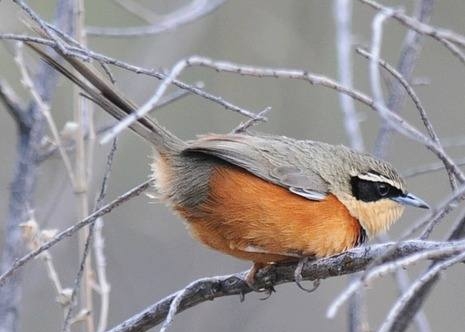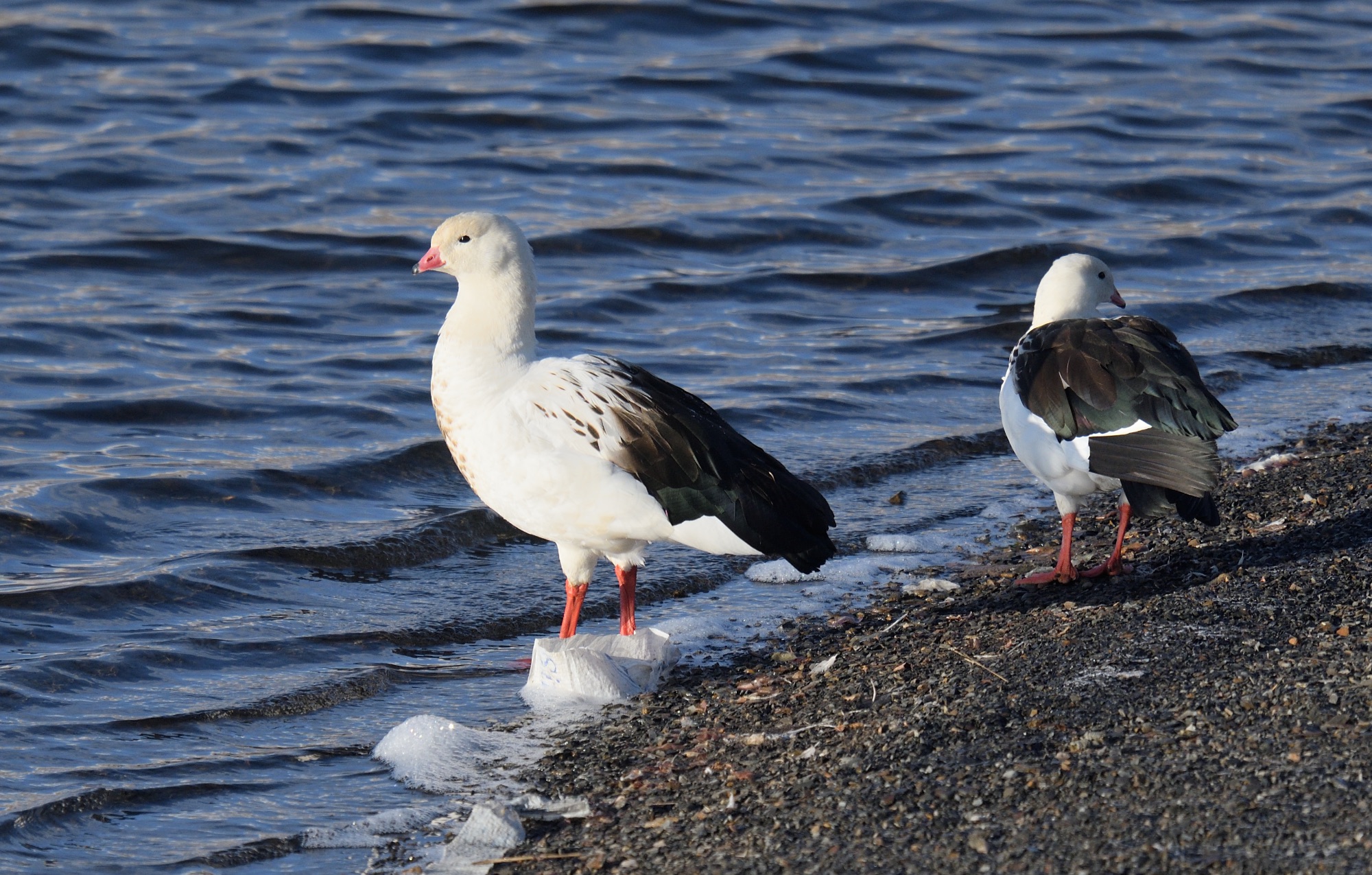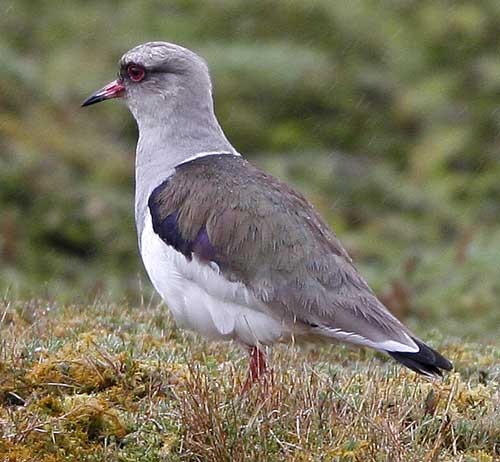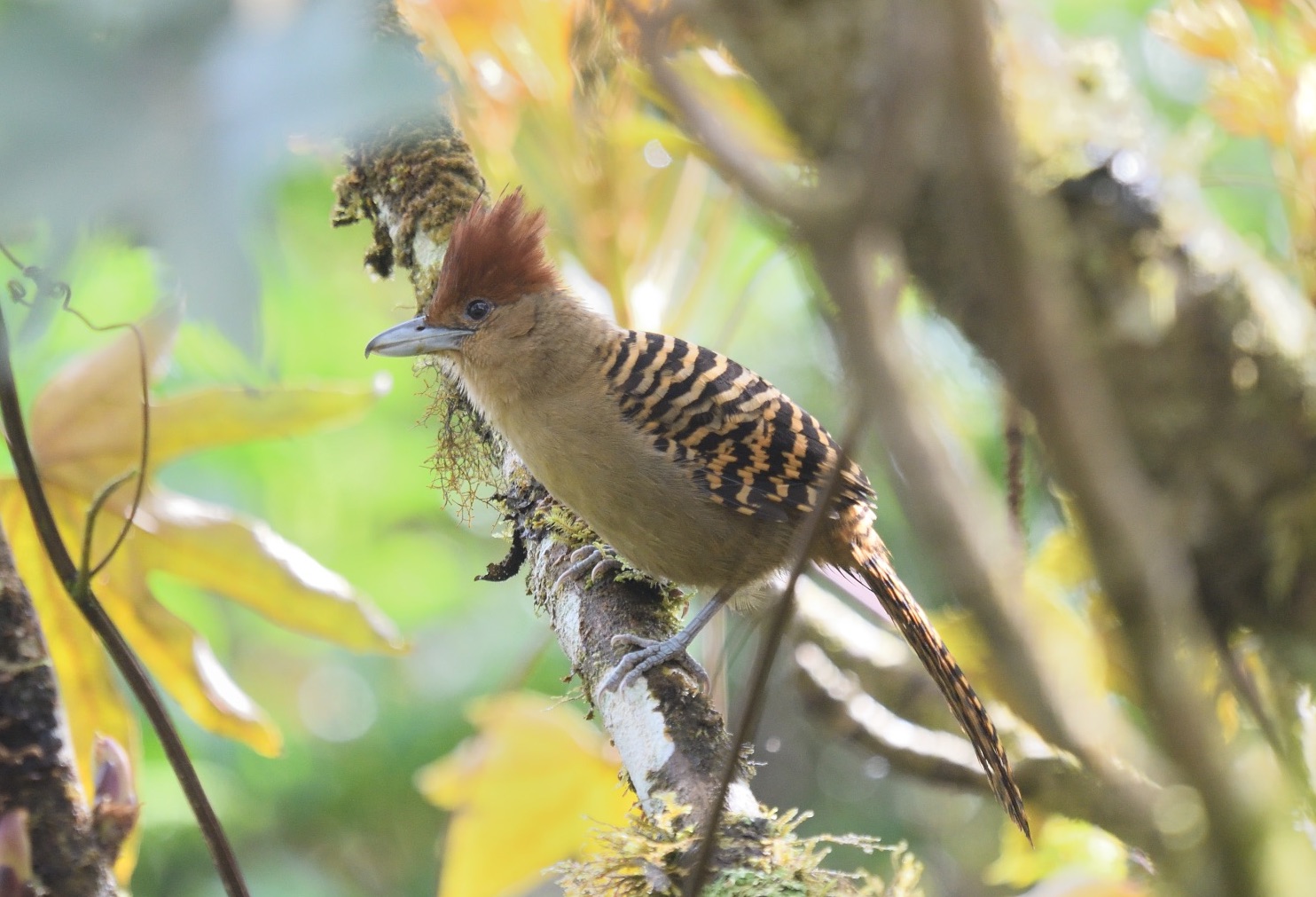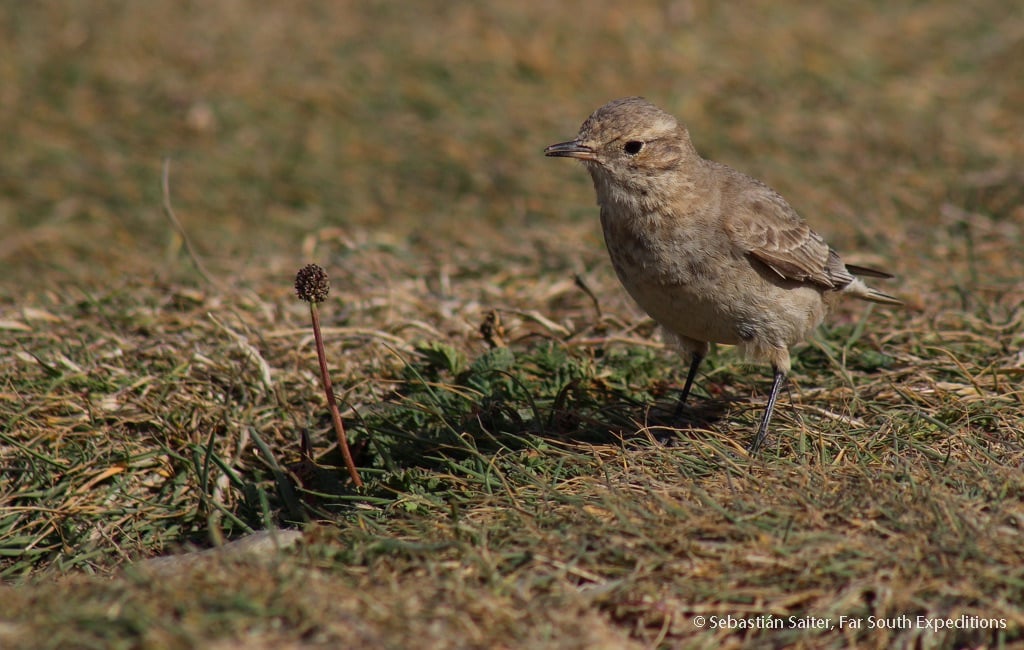NW ARGENTINA
Day 1 Arrival in San Miguel deTucumán Airport - 17th September 2021
Today is purely an arrival day in San Miguel de Tucumán, Argentinaand no activities are planned. Night in San Miguel de Tucumán.
Day 2 Tafí del Valle
From Tucumán we will drive south of the city and into the mountains along the Rio Sosa Valley towards Tafí del Valle, where we’ll spend the following 2 nights. We will make some birding stops along our route, which varies a great deal in altitude from 2,000 meters in Tafí, to roughly 500 meters above sea level near Tucumán and should produce a wide cross-selection of species. Chances are good here for Rufous-throated Dipper bobbing on rocks amidst the fast-flowing roadside river and also for Torrent Duck as well. Amongst numerous other possibilities we could encounter Scaly-headed Parrot, Mitred Parakeet, Plush-crested Jay, Buff-browed Foliage-Gleaner, Small-billed Elaenia, Brown-capped Redstart,Golden-rumped Euphonia, Sayaca Tanager, Black-backed Grosbeak, and endemic Yellow-striped Brush-Finch amongst others. Night in Tafí.
Day 3 Tafí del Valle
This is going to be an exciting day as we will spend the day birding a variety of habitats and elevations up to a height of 3200m around Tafí del Valle including puna grasslands and yungas cloud forest where a multitude of Andean birds await us. In particular we will look for species endemics such as Moreno’s Ground-Dove, White-browed Tapaculo and Yellow-striped Brush-Finch, whilst other key target species include Yungas Dove, Rufous-throated Dipper, Rothschild's Swift, and there’s always a chance of finding the rare Tucumán Mountain-Finch today.
The list of other potential species here is huge and some of the highlights could include Ornate and Andean Tinamou, Torrent Duck, Black-winged Ground-Dove, White-barred Piculet, Dot-fronted and Cream-backed Woodpeckers, Mitred Parakeet, Scaly-headed Parrot, White-bellied Hummingbird, Red-tailed Comet, Buff-browed Foliage-Gleaner, Highland Elaenia, Buff-banded Tyrannulet, Slender-billed Miner, Buff-breasted Earthcreeper, Streak-fronted Thornbird, Cream-winged Cinclodes, Scribble-tailed, Puna and Cordilleran Canasteros, Streak-throated Bush-Tyrant, Rufous-capped Antshrike, Andean Slaty-Thrush, White-winged Becard, Andean Swift, Brown-capped Redstart, Stripe-crowned and Azara’s Spinetails, Cinereous and Spot-billed Ground-Tyrants, Black-billed Shrike-Tyrant, Buff-browed Foliage-Gleaner, Rough-legged and Sclater’s Tyrannulets, Mountain Wren, Hellmayr’s Pipit, Fulvous-headed and Stripe-headed Brush-finches, Fawn-breasted Tanager, Rusty-browed Warbling-Finch, Band-tailed and Plumbeous Sierra-Finches, Plain-coloured Seedeater and Golden-winged Cacique. Night in Tafí.
Day 4 Tafí del Valle - Cafayate
After breakfast we will head north towards Cafayate, climbing ever upwards until reaching El Infiernillo mountain pass at 3,042m. On our way there we’ll look for endemics such as Moreno’s Ground-Dove, White-browed Tapaculo, the very rare Steinbach’s Canastero and Tucuman Mountain-Finch. Other species along our route today include Andean Condor, Black-billed Shrike-Tyrant, White-winged Cinclodes, Buff-breasted Earthcreeper, Rufous-banded and Slender-billed Miners, Andean Swift, Paramo Pipit, Cordilleran and Puna Canastero, Patagonia Mockingbird, Mourning Sierra-Finch, Greenish Yellow-Finch and sometimes the endemic Yellow-striped Brush-Finch and Monte Yellow-Finch are present. After crossing El Infiernillo, we will descend down to the Province of Salta, and start exploring a slightly different habitat of dry thorny scrubland with rocky cliffs and sandy soil, known as Monte of the Calchaqui Valleys. In this area we’ll visit the Quilmes Ruins, one of the largest pre- Columbian settlements in Argentina, where around 5,000 people used to live many years BC. Despite being dry, this habitat is surprisingly full of new birds, including some superb endemics like White-throated Cacholote and Sandy Gallito, as well as Burrowing Parrot, Chimango Caracara, Grey-hooded Parakeet, Guira Cuckoo, White-fronted and Checkered Woodpeckers, Brown-capped Tit-Spinetail, Chaco Earthcreeper, Rusty-vented Canastero, Greater Wagtail-Tyrant, Southern Martin, Golden-billed Saltator, and Chaco (Ringed) Warbling-Finch.
Other possibilities for today include flocks of Burrowing Parrot (northern race), Spot-winged Pigeon, White-sided Hillstar, the attractive White-fronted Woodpecker, Tufted Tit-Tyrant, Sharp-billed Canastero, Scale-throated and Chaco Earthcreepers, D’Orbigny’s Chat-Tyrant, White-crested Tyrannulet, White-banded Mockingbird, Greater Wagtail-Tyrant, Grey-hooded Sierra-Finch, Blue-and-yellow Tanager and Black-crested Finch. Night at Cafayate.
Day 5 Cafayate - Cabra Corral
We’ll leave Cafayate this morning and continue north to Cabra Corral, where we’ll spend the following 2 nights. On our way there, we’ll cross some of the most spectacular rock formations in NW Argentina at Quebrada de las Conchas, where besides enjoying the spectacular scenery we’ll have our first chances for the elusive Black-legged Seriema. There are a number of other potential target species that we have a chance for today and also later in the tour such as Elegant Crested Tinamou, Least Seedsnipe, Tawny-throated Dotterel, Spot-backed Puffbird, the endemic White-throated Cacholote, Long-tailed Meadowlark, Spectacled Tyrant, White-tipped Plantcutter, Great Pampa-Finch, and the endemic Cinnamon Warbling-Finch. Night at Cabra Corral.
Day 6 Cachi Road
- Los Cardones National Park
We will spend the day birding at different altitudes and habitats, following the famous Cachi Road. This winding road climbs all the way up to Cuesta del Obispo (Bishop’s Raise) at 3,500m and offers chances to find Elegant Crested Tinamou, Variable Hawk, Aplomado Falcon, Andean Flicker and Rock Earthcreeper. We’ll explore the gullies looking for White-tipped Plantcutter, Brown-capped Tit-Spinetail, Yellow-billed Tit-Tyrant, White-winged Black-Tyrant, Black Siskin, Rufous-sided Warbling-Finch and the localized Rufous-bellied Mountain-Tanager. We will also spend some time at lower altitudes looking for Subtropical Doradito and Streak-throated Bush Tyrant. Flowering tobacco bushes attract hummingbirds like Giant Hummingbird and the striking Red-tailed Comet, and the dry slopes along the way are home to Andean Tinamou. On our way to Cachi, we will search for other Andean specialities such as Zimmer’s Tapaculo and the endemic Steinbach’s Canastero. Night at Cabra Corral.
Day 7 Cabra Corral to Las Lajitas
We’ll leave Cabra Corral after breakfast for our next destination of Las Lajitas, in the heart of Salta’s dry Chaco woodland. To get there, we’ll take a dirt back road through good montane Chaco habitat with some transitional forest and agricultural land, which after a few kilometres connects to the main highway. The first part of this road goes through a canyon, where chances are good for birds like Andean Condor and Black-chested Buzzard Eagle, Chaco Chachalaca and Dusky-legged Guan are common sightings along the way and other possible birds include White-bellied Hummingbird, Blue-throated Starthroat, Ringed Kingfisher, Cream-backed Woodpecker, Rock Earthcreeper, Maquis Canastero, Narrow-billed Woodcreeper, White-winged Black-Tyrant, Brown-crested Flycatcher, Many- coloured Chaco Finch, Red Pileated Finch, Ultramarine Grosbeak, Rufous-bellied Mountain-Tanager and Black-legged Seriema among others. On our way to La Lajitas we will cross an area of wetlands where chances are good for species such as Roseate Spoonbill, Southern Rough-winged Swallow and Amazon Kingfisher, and this is also a good area for Turquoise-fronted Amazon. We will spend the following two nights in Las Lajitas.
Day 8 Chaco
We’ll leave very early this morning and drive north to the area of La Estrella, where dense stocks of dry Chaco Forest still stand. Our plan is to spend the morning looking for specialties including Darwin’s Nothura, Tataupa, Brushland and Quebracho Crested Tinamou, Black-legged Seriema, Spot-winged Falconet, Olive-crowned Crescentchest, Stripe-backed Antbird and Short-billed Canastero to name but a few. Other species include Savanna Hawk, Aplomado Falcon, Blue-crowned Parakeet, Ash-coloured Cuckoo, Ferruginous Pygmy-Owl, Tropical Screech-Owl, Nacunda Nighthawk, Blue-tufted Starthroat, Cream-backed Woodpecker, Red-billed Scythebill, Crested Hornero, Pale-breasted Spinetail, Little Thornbill, Lark-like Brushrunner, Brown Cacholote, Stripe-backed Antbird,Tawny-crowned Pygmy-Tyrant, White Monjita, Rufous Casiornis, Many-coloured Chaco-Finch and Screaming Cowbird amongst others, whilst Greater Rhea can usually be spotted in farmlands along the way too.
We will return to Las Lajitas around noon, in time to have lunch and take a midday break to avoid the heat, before setting off for the area of Joaquín V. González where we’ll spend the balance of the day birding the farmland and Chaco woodland around town. We’ll have plenty of time to walk around and look for birds in the thorny Chaco forest, where we hope to find White-fronted woodpecker,Great Antshrike, Scarlet (formerly Vermilion) Flycatcher, Great Rufous and Scimitar-billed Woodcreepers, Straneck’s Tyrannulet, Solitary Cacique, Greyish Saltator, Cinereous Tyrant, Crowned Slaty Flycatcher, Hepatic Tanager, Ultramarine Grosbeakand woodpeckers including White-fronted, Checkered and Green-barred. In the farmlands we might get falcons like Aplomado and Peregrine, also Smooth-billed Ani and passerines such as White-browed Blackbird, Southern Yellowthroat and Tropical Kingbird. As dusk approached we can begin our search for Little and Scissor-tailed Nightjars, whilst Chaco Owl and Common Potoo will be our main priority after dark. Night at Las Lajitas.
Day 9
Las Lajitas to Libertador General San Martín
We’ll leave Las Lajitas after breakfast and bird our way to Libertador General San Martín, where we hope to arrive around noon, in time to have lunch at a local restaurant and check into our hotel for the following two nights. This afternoon we will explore transitional forest and wet lowlands along the entrance road to Calilegua National Park, where we’ll look for birds including Pale-vented Pigeon, Rothschild’s Swift, Toco Toucan, Golden-collared Macaw, Azara’s Spinetail, Ochre-faced Tody-Tyrant, Purple-throated Euphonia and Crested Oropendola among others. Night at Libertador General San Martín.
Day 10
Calilegua National Park
Calilegua National Park (70,000 hectares) is one of the main Yungas relicts within Argentina. Habitats range from the lower plains up into subtropical evergreen ‘yungas’ forest, into temperate mossy forest and Podocarpus woodland. We’ll head straight to the lower Yungas at the entrance of the park stopping often along the way, searching some trails for new birds like Green-cheeked Parakeet, Olivaceous Woodcreeper, Slaty and Highland Elaenias, Ochre-faced Tody-Flycatcher, Plumbeous Tyrant, Dusky-capped Flycatcher, Green-backed Becard and Blue-crowned Trogon among others. If we are lucky, we might also get Amazonian Motmot, a bird that is rather uncommon in Argentina and highly restricted to this corner of the country.
We will stop for a picnic lunch at Mesada de las Colmenas, a wonderful picnic site half way up the road across Calilegua, and can be great for watching raptors such as Rufous-thighed Hawk, Plumbeous Kite, American Swallow-tailed Kite, White-rumped Hawk and King Vulture. This is also a good place for secretive White-throated Antpitta and we will try hard for this one here. While trying for the antpitta, we’ll also have good chances for other wonderful birds such as Dusky-legged Guan, Yellow (Golden) Collared Macaw, White-bellied Hummingbird, Planalto Hermit, Slender-tailed Woodstar, Black-banded Woodcreeper, Giant and Variable Antshrikes, Black-capped Antwren, Rusty Flowerpiercer, Cinnamon Flycatcher, Mountain Wren, Two- banded Warbler, Spotted Nightingale-Thrush and Andean Slaty Thrush. At night we have chances of Yungas Screech-Owl and Rufous Nightjar. Night at Libertador General San Martín
Day 11
Libertador General San Martín - Purmamarca
We’ll leave Libertador General San Martín this morning and head northwest toward our next destination of Purmamarca, a lovely village sitting at the foothills of mighty Andes in the southern end of the Humahuaca Valley. Rather than taking the shorter road there, we will start by driving slightly south to take an alternative road crossing Santa Laura mountain pass, which is a wonderful birding area. This road crosses some transitional forests and wetlands, offering great chances for birds like Golden-Olive Woodpecker, Whistling Heron, Spot-breasted Thornbird, White Monjita, Fork-tailed Flycatcher, Slaty Elaenia, Rufous-browed Peppershrike, Purple-throated Euphonia, Rusty-browed Warbling Finch, White-browed Brush-Finch, Saffron-billed Sparrow, and Band-tailed Seedeater to name but a few. Some prominent and easy to spot birds like the spectacular Crested Oropendola and the inquisitive Plush-crested Jay are also possible sightings along the way. Raptors are a bit unpredictable, but Barred Forest Falcon, Short-tailed Hawk and King Vulture are all present here, especially as we get deeper into another patch of Yungas, which we’ll cross en-route to Purmamarca where we plan to arrive in the afternoon.
We will check into our selected hotel for the following two nights, and then spend the rest of the day birding around town and enjoying the spectacular surroundings, including Cerro del los Siete Colores (Seven-colour Hill). Chances are good this afternoon for new birds like White-bellied Hummingbird, Slender-tailed Woodstar, Brown-backed Mockingbird, Highland Elaenia, Sclater’s Tyrannulet, Golden-crowned Warbler, Fulvous-headed Brush-Finch, Rusty-browed Warbling-Finch and Black-hooded Sierra-Finch among others. Night in Purmamarca.
Day 12 Yala -Purmamarca
Today we will look for the striking Torrent Duck and the scarce Rufous-throated Dipper, in case we missed them before. We will also explore a local reserve in the area looking for specialties of the Alder forest such as Golden-olive and Dot-fronted Woodpeckers, Spot-breasted Thornbird, Short-billed Canastero, Rufous-capped Antshrike, Two-banded Warbler, Fawn-breasted Tanager, Rusty-browed Warbling-Finch and the scarce and elusive Red-faced Guan. Chances are good this afternoon for new birds like Brown-backed Mockingbird, Yellowish Pipit, Screaming Cowbird, and Black-hooded Sierra-Finch among others. We will spend the balance of the day birding around town and enjoying the spectacular surroundings. There’s also a lake along the way that has Coscoroba Swan, Brazilian and Cinnamon Teal, Rosy-billed Pochard, and both White-winged and Red-gartered Coots. Night at Purmamarca.
Day 13 Purmamarca - Huacalera
After enjoying an early breakfast surrounded by the beautiful landscape of blue mountains and deep valleys, we will spend a couple of hours searching for local specialties we still need for our lists. After this we will travel north entering the Humahuaca Valley where the attractive geological formations and the varied colours of the mountains give an adequate frame to ancient adobe villages and old churches of Cuzco influence that make Humahuaca Canyon such a spectacular place, worth enough for UNESCO to declare it a World Heritage Site. Night at Huacalera.
Day 14 Huacalera - Lake Pozuelos - La Quiaca
Today we will continue north, to finally enter the Puna region. This will be a day of fascinating contrasts as we gradually move to higher elevations along the Humahuaca Canyon before reaching La Quiaca where we will stay for two nights. The Lake Pozuelos Natural Monument is a mountain-ringed basin with shallow brackish water located roughly 90 kilometers north of Pampa. This area hosts a huge population of Andean, Chilean and Puna Flamingo’s, so large concentrations of these creatures can be seen amidst the solitude and grandeur of this unique high Andean landscape. Depending on the water level variation, chances are also high here or in the surroundings for other Puna specialties such as Andean Goose, Andean Avocet, Crested Duck, Puna Teal, Andean, Horned and Giant Coots, Puna Plover and a number of North American migrants such as Baird’s & Pectoral Sandpipers and Wilson’s Phalarope. We will also explore the surrounding grasslands in search of Tawny-throated Dotterel, American Golden Plover and Least Seedsnipe. Other local birds possibly seen today include Andean Gull, Mountain Caracara, Cinereous Harrier, Common Miner, Andean Flicker, Golden-spotted Ground-Dove, Andean Negrito, Bright-rumped Yellow-Finch and hopefully Ornate Tinamou. Your day in Pozuelos will also provide excellent chances for the local race of Lesser Rhea – called Puna Rhea in some books. Night at La Quiaca
Day 15 Yavi and High Andean Puna
We will spend the day birding the high Andes around the Village of Yavi and Cuesta del Izoite driving through the higher Altiplano, searching for birds like Lesser Rhea, Grey-breasted Seedsnipe, Tawny-throated Dotterel, Andean Condor, Variable Hawk, Giant Hummingbird, Wedge-tailed Hillstar, White-winged and Cream-winged Cinclodes, Straight-billed Earthcreeper, Plain-breasted Earthcreeper, Creamy-bellied and Cordilleran Canastero, Chilean Elaenia, Grey-bellied Shrike-Tyrant, D’Orbigny’s Chat-Tyrant, and Black Siskin to name but a few local specialties. Other species to be seen around La Quiaca include Andean Condor, Brown-capped Tit-Spinetail, Citron-headed Yellow-Finch, Puna, Black-fronted and Spot-billed Ground-Tyrants, Common Chlorospingus, Black-hooded, Mourning and Red-backed Sierra-Finches, Citron-headed and Puna Yellow-Finches. We also hope to find the delightful Vicuña, a delicate wild cousin of the Llama. Night at La Quiaca
Day 16 La Quiaca - Jujuy or Salta – End of Tour – 2nd October
Time permitting we will do some final birding this morning before starting our journey to Jujuy or Salta Airport, where the tour ends.
All photos copyright Nick Bray/Zoothera Birding unless otherwise stated.
Just hover your cursor over each image for info.

